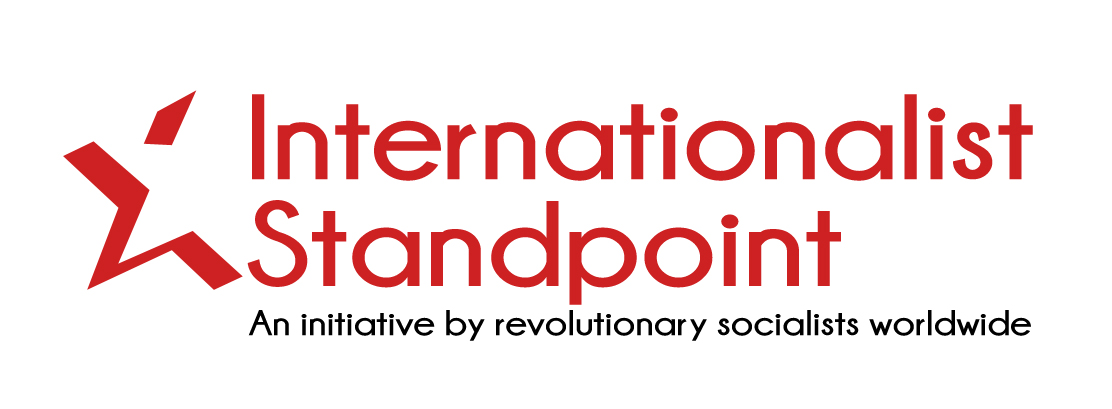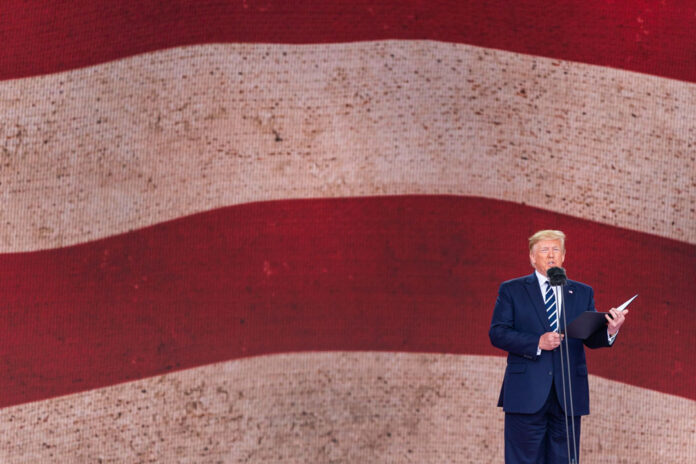The following text is International Standpoints’ written contribution to the 3rd Internationalist Meeting, which took place in Paris, May 16-18.
Trump’s return to power is part of the generalized rise of the Far-Right (FR) globally but it gives this process a new dimension and a new dynamic. It boosts the self-confidence of the FR internationally as well as that of the fascist organizations/currents. At the same time, it throws the parties of the Left into further disarray and deeper crisis.
Geopolitically, Trump is causing tectonic shifts of what has been considered as stable in recent decades. Most important is the huge rift created between the US and the European powers. This alliance was one of the key factors that enabled the West in general and the US in particular to dominate the planet, particularly after the collapse of the Soviet Union.
Attacking the European powers will not only undermine Europe’s weight globally but also weaken the dominance of the US.
Imposing tariffs across the board will backfire, undermining the US and the global economy.
The rise of Trump is a reflection of the depth of the crisis faced by global capitalism and especially by the industrially developed countries.
It is at the same time, however, a reflection of the “weakness” of the working-class organizations, trade union and political, of all shades of the “reformist” Left but also the anticapitalist Left.
Economy
Capitalism was never really able to overcome the 2007-8-9 crisis. Whatever growth took place in the course of the last one and a half decades has been at the expense of high budget deficits and rising public (sovereign) debts. In the US the debt has been in the region of 120-125% in the past couple of years – higher than even in 1946(after WWII). For the OECD as a whole, the average public debt is over 90% of GDP.
At the same time the share of both the EU and the US, in global trade and global production, is falling.
The trade war started by the US against China in 2017 played a role in the fall of the rates of growth of the Chinese GDP, but it has not been able to solve the central problem of US capitalism, i.e., the danger of being overtaken by China. This puts US capitalism in a state of “desperation”, and the rise of Trump is a reflection of this factor.
Subjective factor
The crisis of the parties of the Left is the second crucial factor for the rise of the Far Right in general and of Trump in particular. Not only the old parties of the “Social-democratic” and “Labour” but also “Communist” type (with rare exceptions), have completely capitulated, but also the “New Left”(SYRIZA, Podemos, Left Block, Corbyn, Sanders, etc) have shown to be completely incapable of offering a way forward.
In the vacuum that was created the Anti-capitalist Left failed to intervene and create sizeable forces. Instead, it also fell in crisis, with further splits and weakening of its forces, despite the opportunities that exist.
Tariffs
Trump is imposing massive tariffs in every direction and threatening with more if there is retaliation. This is causing a melt-down in the equity markets, with about 10 trl USD lost by the time of writing (April 8).
US tariffs are inevitably causing retaliation. China, the EU, Canada, Mexico, Brazil, etc, have either already announced tariffs on US imports as a responseor are contemplating how to react.
Increased tariffs will mean slowing down of global trade and global GDP growth. They can throw the US economy into recession. They will also mean higher inflation, in the US and globally, undermining living standards.
Class struggle
The US workers are bound to fight back. For the moment, much of the working class is genuinely stunned. But many are searching for ways to fight.
This must be seen in conjunction with the attack on rights, especially against women and lgbt+ people, with the rise of racism, with the issue of war and that of climate which will anger people, particularly young.
Similar processes can be expected internationally. Trump’s administration is providing a boost to the FRglobally. The conservative and reactionary agenda of the FR will cause a backlash in big sections of the populations. Coupled with economic stagnation and probable recession class polarization and struggle are bound to increase.
Ukraine
The U-turn by Trump means that the European powers are left with a war in their hands which raises demands that they cannot fulfill. They pretend to continue fighting Russia and to reject “unacceptable terms” (eg demanding that Russian leaves Ukraine unconditionally…) but this is just to save face. The position they find themselves in, is that on the one hand they have to hugely increase military spending and on the other feel the impact of a defeat in Ukraine.
After Trump’s refusal to finance NATO presence in Europe, they plan to raise massively their expenditure on arms (to the level of € 800 bn over the next decade besides big increases on a national level, especially by Germany) at a time when they face large budget deficits and high sovereign debts.
In order to justify these expenditures, there is a policy of “social militarization” in Europe, a new massive propaganda about the need to build a “war economy”, asking people to have sufficient food supplies and cash at home, etc.
China
At the core of Trump’s MAGA, is the fight against China.
One of the declared aims was to cut down the trade surplus of China with the US and the rest of the world. Seven years of trade wars by Trump and by Biden have not solved this problem. China continues to challenge the US on every level. A look at the facts and figures of today, indicatesthat the policies applied by the US, followed by Europe, have not succeeded in their aims.
Thus, for example, China’s trade surplussoared to a record last year, reaching an unprecedented $ 992 bn in 2024–21% higher compared to 2023, and the highest since statistics began to be kept in 1998.
The new tariffs against China will of course have an impact on China’s GDP, but this cannot be of a detrimental characteras the total amount of Chinese exports to the US is only around 3% of the Chinese GDP. Over the past years China has been diverting exports, precisely because of the Wests’ trade war, through bilateral and regional trade agreements, to Asia, L. America, Africa and the Middle East. The same is the case with Chinese capital invested abroad.
The threats that Trump is throwing in every direction will actually push countries towards China and away from the United States.
What is more probable is that Trump’s policies will not isolate China from the rest of the global economy and increase the United States share in it, but produce the opposite effect, i.e., lead to an increase in trade between the rest of the world at the expense of the US.
This is relevant to the European powers as well, despite the long-standing relations between Europe and the US.Given the present Trump administration’s policies, a gradual turn towards more “balanced” relations with China on the part of the EU would not be surprising.
Fascism?
Elon Musk’s Nazi salute and the erratic behavior of Trump and his cabinet have added fuel to the ongoing discussion about whether Trump is a fascist. Big sections of the Democrats used the argument that Trump is a fascist in their election campaign hoping in this way to stop him. Quite a few on the Left have also raised the idea that the Trump regime is “fascistic”.
Of course, there are elements of authoritarianism In Trump’s administration but this is different from fascism or an authoritarian state/regime. Τhe conditions for the establishment of fascism in the US or the rest of the industrially developed countries do not exist today.
Fascism is not something related to the characteristics or aspirations of this or that individual. It’s a regime which crashes every democratic right and institution not only of the working class but also of the ruling class (i.e. parliamentary democracy) – through the use of frenzied layers whose lives have been destroyed by the crisis.
There are major differences between today and the 1930s. On the one hand the crisis of capitalism was much deeper than today, creating millions of destroyed petit bourgeoiswho became Hitler’s storm troops. On the other, the ruling class was worried of the prospect of imminent revolution. As a result, they turned to Hitler.
The establishment of a fascist regime is the final stage in a struggle that ends with the defeat of the working class – a defeat of historic and strategic character. We are not there. We are at the beginning of a process that allows time to gather the forces to fight against the “fascistic perspective”.
Backfire
Trump’s policies will backfire. The rift between the US and the EU is of fundamental importance and is actually weakening the US in its attempt to contain China. The crisis of the EU, already deep, will intensify. This is despite the fact that additional efforts will be made in the direction of greater convergence especially on the level of military expenditure. The EU’s turn in the direction of “social militarization” at the expense of social services and living standards will be an additional factor for radicalization in Europe.
Trump represents a serious danger on many levels both for the US and the international working class because of the boost it gives to the FR internationally. But at the same time, it creates opportunities for Marxist forces, precisely because it intensifies class struggle and polarization. The rise of the FR, with its conservative/reactionary agenda is bound to cause a reaction, especially in younger layers, and a feeling that we need to fight back.
The anticapitalist Left in the past years, has failed to provide a way forward. There are a number of reasons for this in our opinion:
• Certain sections have fallen into opportunism and liquidationism.
• There is no sufficient involvement in working class and social struggles.
• There is no correct understanding of the United Front, which by definition means revolutionaries acting together with reformists on various levels
• Differences are not discussed in a flexible manner, allowing for an open approach and experimentation, but are elevated to “principles” ending up in polarized debates and fragmentation.
The sections of the revolutionary Left that understand these deficiencies need to come together and make serious efforts to discuss and overcome them.



